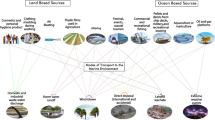Abstract
The concentration of PCB, as Aroclor 1254®, accumulated from sandy sediment byNereis virens is directly related to PCB concentration in sediment and to exposure time, and is inversely related to worm size. There was no indication of equilibrium concentrations being attained during 32 days' exposure. Concentration factors at 32 days ranged from 10.8 for 0.6-g worms to 3.8 for 4.7-g worms. There was no obvious excretion of PCB byN. virens during 26 days' post exposure.
Accumulation of PCB byCrangon septemspinosa is directly related to PCB concentration in sediment and inversely related to animal size. Concentration factors at 32 days ranged from 3.5 for 0.1-g shrimp to 1.9 for 2.9-g shrimp.
Field collectedN. virens ranging in weight from 1.3 to 20.0 g were analyzed for PCB, ΣDDT and dieldrin. Smaller worms had accumulated more per unit weight of each compound than larger worms.
Similar content being viewed by others
References
Akagi, H., and D. Wildish: Determination of the sorting characteristics and organic carbon content of estuarine sediments. Fish. Res. Board Can. MS Rep.1370, (1975).
Blau, G., and G. Agin: A users manual for BIOFAC: A computer program for characterizing the rates of uptake and clearance of chemicals in aquatic organisms, Dow Chemical Co., Midland, MI (1978).
Courtney, W., and W. Langston: Uptake of polychlorinated biphenyl (Aroclor 1254) from sediment and from sea water in two intertidal polychaetes. Environ. Pollut.15, 303 (1978).
Day, D., and A. Brafield: The energy relations of the polychaeteNeanthes(=Nereis) virens (Sars). J. Anim. Ecol.42, 673 (1973).
Dexter, R., and S. Pavlou: Mass solubility and aqueous activity coefficients of stable organic chemicals in the marine environment: Polychlorinated biphenyls. Mar. Chem.6, 41 (1978).
Eder, G.: Polychlorinated biphenyls and compounds of the DDT group in sediments of the central North Sea and the Norwegian depression. Chemosphere5, 101 (1976).
Elder, D., S. Fowler, and G. Polikarpov: Remobilization of sediment-associated PCBs by the wormNereis diversicolor. Bull. Environ. Contain. Toxicol.21, 448 (1979).
Fowler, S., G. Polikarpov, D. Elder, P. Parsi, and J.-P. Velleneuve: Polychlorinated biphenyls: Accumulation from contaminated sediments and water by the polychaeteNereis diversicolor. Mar. Biol.48, 303 (1978).
Jensen, S., L. Renberg, and L. Reutergardh: Residue analysis of sediment and sewage sludge for organochlorines in the presence of elemental sulfur. Anal. Chem.49, 316 (1977).
Linko, R. R., P. Rantamke, and K. Urpo: PCB residues in plankton and sediment in the southwestern coast of Finland. Bull. Environ. Contam. Toxicol.12, 733 (1974).
Moriarty, F. (ed.): Organochlorine insecticides: Persistent organic pollutants. London: Academic Press (1975).
Nimmo, D., P. Wilson, R. Blackman, and A. Wilson: Polychlorinated biphenyls absorbed from sediments by fiddler crabs and pink shrimp. Nature231, 50 (1971).
Pavlou, S. P., and R. N. Dexter: Distribution of polychlorinated biphenyls (PCB) in estuarine ecosystems. Testing the concept of equilibrium partitioning in the marine environment. Environ. Sci. Technol.13, 65 (1979).
Webb, R., and A. McCall: Quantitative PCB standards for electron capture gas chromatography. Chromatogr. Sci.11, 366 (1973).
Wildish, D., C. Metcalfe, H. Akagi, and D. McLeese: Flux of Aroclor 1254 between estuarine sediments and water. Bull. Environ. Contam. Toxicol. Submitted (1979).
Zitko, V.: The interference of aromatic hydrocarbons in the determination of PCBs. Amer. Chem. Soc., Proc. 4th Joint Conference on Sensing of Environmental Pollutants, 757 (1978).
Zitko, V., P. Choi, D. Wildish, C. Monaghan, and N. Lister: Distribution of PCB andp,p′-DDE residues in Atlantic herring(Clupea harengus harengus) and yellow perch(Perca flavescens)in eastern Canada — 1972. Pestic. Monitor. J.8, 105 (1974).
Author information
Authors and Affiliations
Rights and permissions
About this article
Cite this article
McLeese, D.W., Metcalfe, C.D. & Pezzack, D.S. Uptake of PCBs from sediment byNereis virens andCrangon septemspinosa . Arch. Environ. Contam. Toxicol. 9, 507–518 (1980). https://doi.org/10.1007/BF01056931
Received:
Accepted:
Issue Date:
DOI: https://doi.org/10.1007/BF01056931




